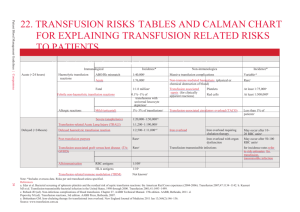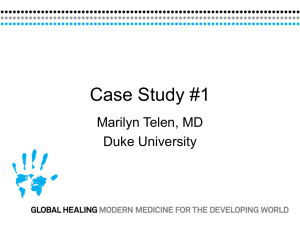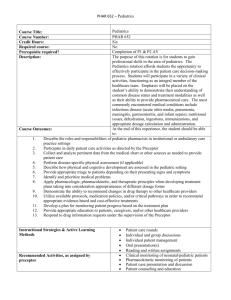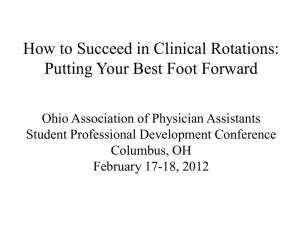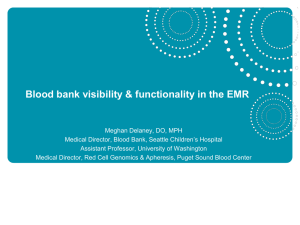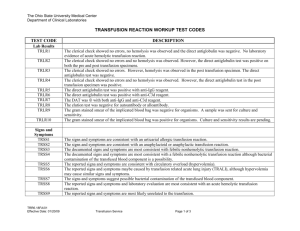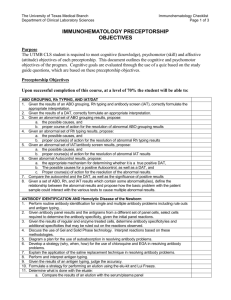Objectives - Austin Community College
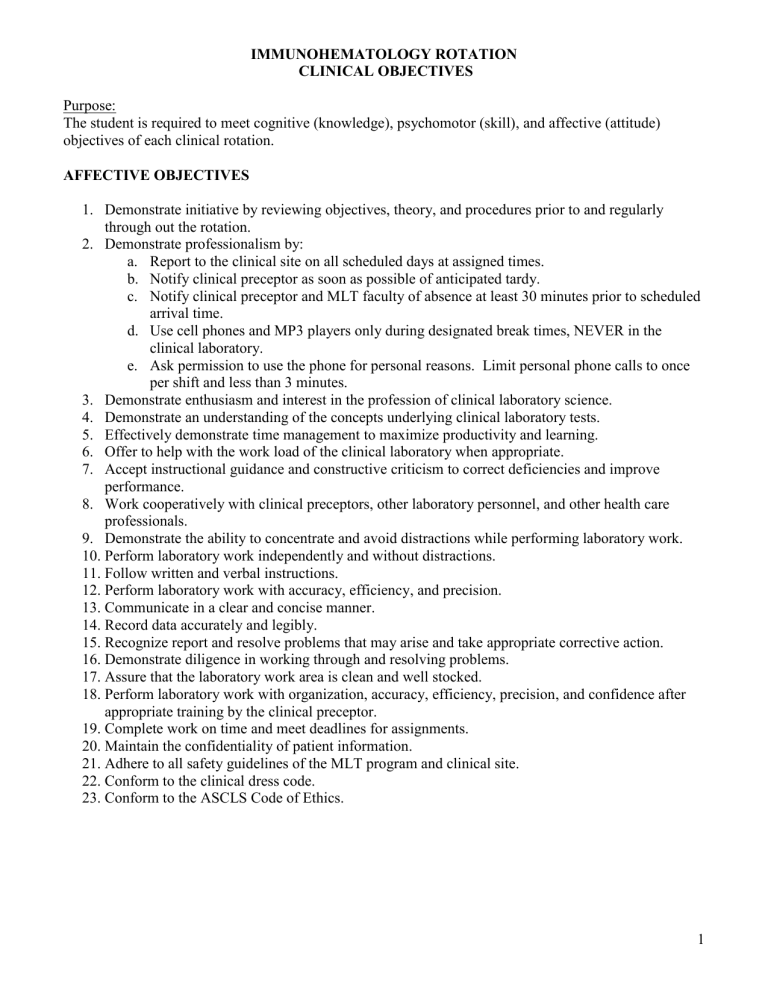
IMMUNOHEMATOLOGY ROTATION
CLINICAL OBJECTIVES
Purpose:
The student is required to meet cognitive (knowledge), psychomotor (skill), and affective (attitude) objectives of each clinical rotation.
AFFECTIVE OBJECTIVES
1.
Demonstrate initiative by reviewing objectives, theory, and procedures prior to and regularly through out the rotation.
2.
Demonstrate professionalism by: a.
Report to the clinical site on all scheduled days at assigned times. b.
Notify clinical preceptor as soon as possible of anticipated tardy. c.
Notify clinical preceptor and MLT faculty of absence at least 30 minutes prior to scheduled arrival time. d.
Use cell phones and MP3 players only during designated break times, NEVER in the clinical laboratory. e.
Ask permission to use the phone for personal reasons. Limit personal phone calls to once per shift and less than 3 minutes.
3.
Demonstrate enthusiasm and interest in the profession of clinical laboratory science.
4.
Demonstrate an understanding of the concepts underlying clinical laboratory tests.
5.
Effectively demonstrate time management to maximize productivity and learning.
6.
Offer to help with the work load of the clinical laboratory when appropriate.
7.
Accept instructional guidance and constructive criticism to correct deficiencies and improve performance.
8.
Work cooperatively with clinical preceptors, other laboratory personnel, and other health care professionals.
9.
Demonstrate the ability to concentrate and avoid distractions while performing laboratory work.
10.
Perform laboratory work independently and without distractions.
11.
Follow written and verbal instructions.
12.
Perform laboratory work with accuracy, efficiency, and precision.
13.
Communicate in a clear and concise manner.
14.
Record data accurately and legibly.
15.
Recognize report and resolve problems that may arise and take appropriate corrective action.
16.
Demonstrate diligence in working through and resolving problems.
17.
Assure that the laboratory work area is clean and well stocked.
18.
Perform laboratory work with organization, accuracy, efficiency, precision, and confidence after appropriate training by the clinical preceptor.
19.
Complete work on time and meet deadlines for assignments.
20.
Maintain the confidentiality of patient information.
21.
Adhere to all safety guidelines of the MLT program and clinical site.
22.
Conform to the clinical dress code.
23.
Conform to the ASCLS Code of Ethics.
1
AUTOMATION
State the principle of operation for the following instrument(s) utilized in the laboratory in which you are rotating: a.
ECHO b.
Gel system
COGNITIVE
Upon completion of this rotation the student will be able to:
1.
Discuss the theory, use, performance, and interpretation of results of the following procedures, including quality control: a.
ABO grouping b.
A subgrouping c.
D typing (including weak D) d.
Other antigen typing e.
Antibody screening test f.
Antibody identification g.
Compatibility testing h.
Direct antiglobulin test i.
Elution j.
Auto-absorption
2.
Correlate clinical and laboratory data.
3.
Discuss and compare all blood groups studied with regard to inheritance, nomenclature, characteristics, and identification of antigens and antibodies, and clinical significance.
4.
Describe and compare the various techniques used in the blood bank (saline, LISS, enzyme, albumin, antiglobulin, gel) with regard to how they are performed and the reasons for their use.
5.
List AABB criteria for donor selection and donor unit processing.
6.
Describe proper preparation, storage, expiration dates, and use of each blood component: packed red blood cells, fresh frozen plasma, platelets, and cryoprecipitate.
7.
Discuss the etiology, laboratory findings, treatment, and prevention of hemolytic disease of the fetus and newborn.
8.
Identify potential candidates for Rh Immune Globulin and determine their eligibility.
9.
Describe and analyze auto-immune hemolytic anemia in terms of: a.
Causes b.
Laboratory findings c.
Acquiring compatible blood
10.
Discuss causes, symptoms, and treatment for transfusion reactions.
11.
Choose appropriate laboratory work-up methods for transfusion reactions.
12.
Select appropriate blood for transfusion for patients, including neonates.
13.
Discuss quality assurance measures currently used for blood components, reagents, and equipment.
14.
Recognize the appropriate AABB Standards regarding laboratory testing, quality control, quality assurance, and component processing, storage, and use.
2
PSYCHOMOTOR
Safety
Use appropriate personal protective equipment at all times when working with patient samples.
1.
Locate all fire extinguishers, eye wash stations, and safety showers.
2.
Locate Materials Safety Data Sheets (MSDS), chemical carcinogen list, and hazardous chemicals list.
Clerical and Sample Preparation
The student should perform the following:
1.
Identify patient name, date of birth (DOB), medical record number (or other identifier used by the clinical facility), and date of sample correlating these identifiers with information on the request form.
2.
Determine suitability of sample in terms of identification, age of specimen, and physical condition.
3.
Process samples in appropriate manner (centrifuge, refrigerate, etc.).
4.
Adhere to appropriate safety precautions when handling specimens.
5.
Complete work sheets and other paperwork, as well as observe computer entries, correctly for each procedure performed.
Testing
Upon completion of this rotation the student should perform the following procedures with 95% accuracy:
1.
ABO grouping
2.
D typing (including weak D)
3.
Other antigen typing
4.
Antibody screening test
5.
Antibody identification
6.
Direct antiglobulin test
7.
Compatibility test
8.
Cord blood work-up
9.
Rh immune globulin work-up
10.
Transfusion reaction work-up - discussion only
11.
Demonstrate an organized performance of the daily workload by performing assigned procedures in a timely fashion.
12.
Observe the preparation and issue blood and components for transfusion.
Quality Control
The student should perform the following:
1.
Perform and document appropriate daily quality control procedures for all blood bank reagents.
2.
Observe, and if allowed, perform and document appropriate daily quality control checks on temperature regulated equipment.
3.
Explain and demonstrate proper operation of available equipment.
3



